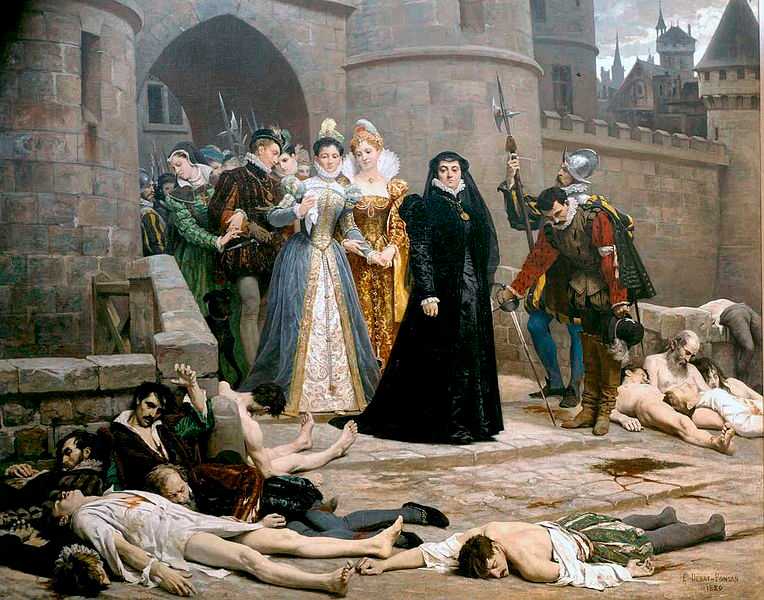 PARIS — Many worldwide have expressed shock and sorrow over the past week following the fire that severely damaged the 800-year-old Notre Dame Cathedral in Paris, France. While millions are being pledged by Roman Catholics and others in an effort to rebuild the facility, the incident has also stirred a remembrance among Christians about the history of the Catholic Church in France — of which Notre Dame is the center — and the bloody massacres that were carried out by Crusaders against religious non-adherents in French history.
PARIS — Many worldwide have expressed shock and sorrow over the past week following the fire that severely damaged the 800-year-old Notre Dame Cathedral in Paris, France. While millions are being pledged by Roman Catholics and others in an effort to rebuild the facility, the incident has also stirred a remembrance among Christians about the history of the Catholic Church in France — of which Notre Dame is the center — and the bloody massacres that were carried out by Crusaders against religious non-adherents in French history.
The Notre Dame Cathedral, which when translated means “The Cathedral of Our Lady,” dates back to the 12th century, with the first stone being laid in 1163 in the presence of then-Pope Alexander.
The structure took 200 years to complete, being finished in 1345, and has undergone repairs in more recent history, including the installation of a central spire in 1852.
On April 8, those inside attending mass had to be evacuated due to a fire, which some now believe is the result of an electrical short-circuit. The building’s roof and spire collapsed in the flames, and millions have been pledged to rebuild the historic building, including from French companies L’Oreal, LVMH and Kering, and U.S. tech giant Apple.
Restoration could take anywhere from 20 to 40 years, reports state.
The matter has generated much discussion, including among Christians who have noted Roman Catholicism’s checkered past in France, and what Notre Dame has represented throughout the centuries.
According to the site Our Baptist Heritage, in the early 12th century, a controversial religious group spreading into France began to draw the ire of the Vatican, even before the building of the cathedral. It seemed that the people were beginning to be attracted to the sect, dubbed the Albigenses, rather than the Catholic Church.
The Albigenses, also known as Cathartists or Cathars, believed that the physical world and all of creation was evil, and reportedly rejected the Old Testament as being of Satan because of the destruction described therein, while the New Testament was good and of God.
“They also … believed that inside the essentially evil human bodies, the spirits of the angels dwelled who were trapped in their flesh cages,” Medieval Chronicles reports.
The group was vocally opposed to Roman Catholicism, and began opening churches and schools to provide an alternative to the people.
“This state of affairs greatly alarmed and aggravated the pope. In the year 1139, they were condemned by the Lateran Council; by that of Tours in 1163, and mission after mission was sent among them to persuade them to return to the Roman Catholic Church,” Our Baptist Heritage outlines. “Cardinal Henry, in 1180, employed force. Pope Innocent III published a crusade against them.”
While the Notre Dame Cathedral was in the midst of being built in the heart of France, Catholic warriors carried out a massacre in order to put down the propagation of heresy. Crusaders reportedly exterminated the Albigenses, killing men, women and children alike — a genocide that Henry Halley’s Bible Handbook calls “scarcely paralleled in history.”
Encyclopedia Britannica also chronicles the Albigensian Crusade, which lasted from 1209 to 1229, outlining that the cause was appealing to Catholics because warriors could earn a plenary indulgence — being completely absolved of sin and skipping “Purgatory” — without having to travel far to participate.
“During the first season, the Crusaders captured Béziers in the heart of Cathar territory and — following the instructions of a papal legate who allegedly said, ‘Kill them all. God will know his own,’ when asked how the Crusaders should distinguish the heretics from true Christians — massacred almost the entire population of the city,” it states.
“In this manner, the war was carried on for twenty years,” Our Baptist Heritage adds. “Town after town was taken, pillaged, burnt. Nothing was left but a smoking waste. Religions fanaticism began the war; rapacity and ambition ended it. Peace was concluded in 1229, and the Inquisition finished the deadly work.”

In the 16th century, French Roman Catholics carried out another massacre, this time on Protestants who agreed with the teachings of Martin Luther and John Calvin on salvation by grace through faith alone. Those following Reformed teaching became known as Huguenots, and faced confiscation of their property by the government, which was also Catholic, as well as violence by those who hated them.
On St. Bartholomew’s Day in 1572, Catholics began killing Huguenots by the thousands in the streets of Paris, mass bloodshed that is stated to have continued for nearly two months. Up to 10,000 people were said to have been murdered, with Protestants being labeled as “heretics.”
“So it was determined to exterminate all the Protestants, and the plan was approved by the queen (Catherine de’Medici),” witness and historian Jacques Auguste de Thou wrote. “The signal to commence the massacre should be given by the bell of the palace, and the marks by which they should recognize each other in the darkness were a bit of white linen tied around the left arm and a white cross on the hat.”
The first to be killed was French admiral Gaspard de Coligny, a Huguenot.
“[A]s soon as they had caused the bell of the palace clock to ring, on every side arose the cry, ‘To arms!’ and the people ran to the house of Coligny. After his body had been treated to all sorts of insults, they threw it into a neighboring stable, and finally cut off his head, which they sent to Rome,” de Thou recounted. “They also shamefully mutilated him, and dragged his body through the streets to the bank of the Seine, a thing which he had formerly almost prophesied, although he did not think of anything like this.”

Pope Gregory XIII ordered a Te Deum to be sung in thanksgiving for the defeat of the Protestant dissidents, and soon had a coin made to commemorate the massacre, which depicted an angel with a sword standing next to murdered Huguenots.
“After the French massacre, all those Roman Catholics who participated in the slaughtering the French Huguenots were awarded a plenary indulgence by the Vatican, which meant that all of their sins were completely forgiven because they murdered French Protestants,” Mike Gendron of Proclaiming the Gospel Ministries in Southlake, Texas told Christian News Network.
Gendron, a former Roman Catholic of more than 30 years, was once asked to give a message to descendants of survivors of the Huguenot massacre.
When asked what he would say to those who would assert that the history of the Catholic Church should be left in the past, he said that Roman Catholic theology has not changed, and its influence on the people remains a concern.
“The ongoing sacrifice of a mass that had taken place in Notre Dame Cathedral four times a day is a re-presentation of Jesus Christ in the form of a wafer, such as that the work of redemption is carried out on an altar, when Jesus [rather] finished it on the cross,” Gendron outlined. “The priest believes he has the power to call the Lord Jesus Christ down from Heaven to be transubstantiated into a wafer to be offered again as a sin offering.”
He also noted that inside Notre Dame in Paris, “there is actually a painting of Christ awarding Mary a scepter and an angel crowning her with a crown because they believe that she is the queen of Heaven.”

Gendron additionally explained that Notre Dame housed a number of Catholic relics, including what was said to be the crown of thorns Jesus wore on his head, and a splinter from Christ’s cross. He further pointed to the beatification of Joan of Arc, who was once deemed a heretic by the same Catholic Church.
Gendron’s two social media posts this past week noting these various aspects have generated much interest, with more than 1,000 likes each and almost the same amount of shares.
“Most people are not aware of the soul-damning influence Notre Dame’s theology has had on millions of Catholics for over 800 years,” Gendron wrote in one post. “Its works-righteousness gospel is depicted on the Cathedral’s ‘Portal of the Last Judgement.’ The angel Michael is using scales to evaluate the life people lived on earth. If enough good works were done, the scales tip and they go to Paradise. If the scales do not tip, they go to Hell. This is in harmony with the fatal works-based gospel of Roman Catholicism.”
“Many people do not know that the construction of Notre Dame was financed in the same way as St. Peter’s in Rome. The money came from people who purchased indulgences to get their relatives out of a fictitious place called Purgatory,” he continued. “This monument that was constructed to honor ‘another Mary’ and ‘another Jesus’ was built with funds received in exchange for ungodly simony.”
Gendron said that while he doesn’t rejoice in the fire, “I could not help but reflect on what the Notre Dame Cathedral actually represents. … The greater tragedy is not the burning of a cathedral, but the eternal consequences that await those who put their trust in a false and fatal gospel.”
Become a Christian News Network Supporter...


